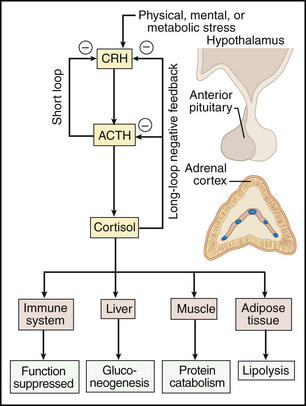71 CASE 71
LABORATORY STUDIES
PATHOPHYSIOLOGY OF KEY SYMPTOMS
Cortisol is the primary glucocorticoid secreted by the adrenal cortex. Secretion is controlled by the hypothalamic corticotropin-releasing hormone (CRH), which stimulates the release of adrenocorticotropic hormone (ACTH) from the anterior pituitary. ACTH stimulates cortisol synthesis and release. Plasma cortisol levels provide a negative feedback inhibition of the release of both ACTH and CRH (Fig. 71-1). Cortisol acts on a variety of target tissues to broadly suppress immune function and to alter glucose and amino acid metabolism. These actions allow the body to adapt to stressful situations, and cortisol is appropriately described as the body’s major stress hormone.

FIGURE 71–1 Cortisol is released in response to physical, mental, and metabolic stress. Cortisol increases the plasma glucose level through a variety of mechanisms (shown in Figure 71-2) and suppresses the action of the immune system. Circulating cortisol levels provide the normal feedback signal inhibiting CRH and ACTH.
Stay updated, free articles. Join our Telegram channel

Full access? Get Clinical Tree


